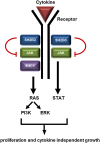The biology of pediatric acute megakaryoblastic leukemia
- PMID: 26186939
- PMCID: PMC4551356
- DOI: 10.1182/blood-2015-05-567859
The biology of pediatric acute megakaryoblastic leukemia
Abstract
Acute megakaryoblastic leukemia (AMKL) comprises between 4% and 15% of newly diagnosed pediatric acute myeloid leukemia patients. AMKL in children with Down syndrome (DS) is characterized by a founding GATA1 mutation that cooperates with trisomy 21, followed by the acquisition of additional somatic mutations. In contrast, non-DS-AMKL is characterized by chimeric oncogenes consisting of genes known to play a role in normal hematopoiesis. CBFA2T3-GLIS2 is the most frequent chimeric oncogene identified to date in this subset of patients and confers a poor prognosis.
© 2015 by The American Society of Hematology.
Figures



References
-
- Pagano L, Pulsoni A, Vignetti M, et al. Acute megakaryoblastic leukemia: experience of GIMEMA trials. Leukemia. 2002;16(9):1622–1626. - PubMed
-
- Athale UH, Razzouk BI, Raimondi SC, et al. Biology and outcome of childhood acute megakaryoblastic leukemia: a single institution’s experience. Blood. 2001;97(12):3727–3732. - PubMed
-
- Barnard DR, Alonzo TA, Gerbing RB, Lange B, Woods WG Children’s Oncology Group. Comparison of childhood myelodysplastic syndrome, AML FAB M6 or M7, CCG 2891: report from the Children’s Oncology Group. Pediatr Blood Cancer. 2007;49(1):17–22. - PubMed
-
- Hitzler JK, Zipursky A. Origins of leukaemia in children with Down syndrome. Nat Rev Cancer. 2005;5(1):11–20. - PubMed
-
- Arber ABR, Orazi A. Acute myeloid leukaemia with myelodysplasia-related changes. In: Swerdlow SHCE, Harris NL, editors. WHO Classification of Tumours of Haematopoietic and Lymphoid Tissues. Lyon, France: International Agency for Research on Cancer; 2008. pp. 124–126.
Publication types
MeSH terms
LinkOut - more resources
Full Text Sources
Other Literature Sources

